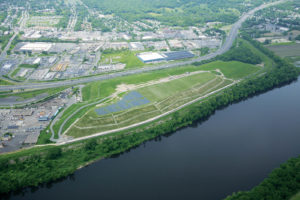
Background
Coal combustion residuals (CCR) management and disposal facilities are facing an onslaught of increased scrutiny regarding environmental concerns in the form of the newly implemented CCR regulations and impending effluent limit guidelines and EPA’s 316(b) requirements for containment and closure regulations.
For decades, geosynthetic materials have consistently provided engineered solutions for a variety of industries, including the municipal waste sector, and have been proven to be cost-effective in their use and implementation. In fact, these recent regulations are similarly based on some of those regulations currently in place for the municipal solid waste industry.
As CCR disposal and management facilities increasingly turn to geosynthetic materials, the geosynthetics industry is answering this call with an even wider range of products, and often these products are being specifically tailored for applications in the coal residuals industry.
This article covers a variety of geosynthetic applications and their ongoing and potential use in CCR management and disposal. It will discuss closure technologies in greater detail as the majority of work is currently focused on the anticipated closures of ash impoundments and landfills.
Materials discussed will include geomembranes, geotextiles, geonets/geocomposites, geosynthetic clay liners, geogrids, synthetic turf systems, and geotextile tubes. Applications discussed will include base liner containment systems, closure systems, and operational systems. It will further discuss the latest developments in the geosynthetics industry, their relevance to the CCR management and disposal industry, and recent trends where these two applications intersect.
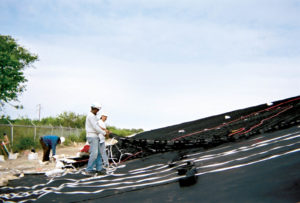
Geomembranes
Typically there are no significant differences required for geomembranes used in CCR management and disposal and those used for similar applications in the municipal waste market.
A geomembrane is an essentially impermeable layer against the migrations of liquid or gas, etc. (per definition used by R. Koerner). During the past 25 years geomembranes have become the predominant choice for barrier/containment layers in disposal and closure applications. Polyethylene (PE) geomembranes comprise the overwhelming majority of these, with high-density polyethylene (HDPE) being the predominant choice for base liners and linear low-density (LLDPE) for final cover systems. Polyethylene geomembrane products offer excellent chemical and UV resistance properties, strong interface shear capabilities, and a track record of containment for decades across numerous industries. Federal regulations governing the municipal solid waste market (Subtitle D) specify a minimum thickness of 60 mils for HDPE geomembranes. Subtitle D also requires that a geomembrane be complemented by a clay component—soil or geosynthetic clay liner (GCL), known as a composite liner system.
PE geomembranes are currently produced by two methods: flat die calendar extrusion and the blown film process. Both methods allow for the production of textured liners for stability against potential veneer failures of the geosynthetic system, however only calendared extrusion allows for the production of structured liners. Textured geomembranes exhibit roughened, sandpaperlike surface(s) on one or both sides, and structured liners utilize large spikes, drainage studs, and grid patterns (or a combination of these surfaces) for applications where a more aggressive approach for stability design is required or where drainage is required.
As part of any design effort, interface friction/shear strength values for each of the proposed geosynthetic interfaces must be taken into consideration as early as possible in the design process. The site-specific soils, expected loading conditions, and unique geosynthetic material layering must be factored into each site design. As the characteristics of the soils may change, as well as the degree of texturing in some geomembrane production methods, it is important to establish testing results during the design phase of the project and after the production of the site specific geosynthetic materials.
In recent years, the technology behind leak detection/location surveys and conductive liners has improved significantly; as a result, these materials and services are marketed more for liner systems in both the CCR and municipal waste sectors. Since it is estimated that the majority of holes or damage to geomembranes occurs during the placement of protective cover materials, many installers, owners, design engineers, and state agencies are increasingly interested in conducting leak detection surveys to prove the integrity of their installations and minimize their liabilities1. Leak location surveys are a critical tool that can be specified during construction to identify potential areas of concern in a liner system. Regardless of the cause, these areas can be identified and repaired prior to the placement of waste in the containment area. Leak location surveys can easily be performed on geomembranes and can be performed before and after the placement of cover soils and even through varying thicknesses of a waste after waste placement has begun.
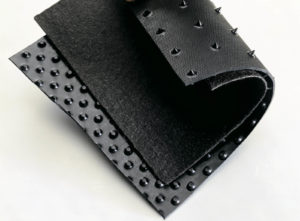
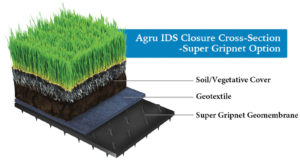
Courtesy Agru America
Geotextiles
Geotextiles are the widest used type of geosynthetics with an extreme variety of applications both in the environmental and disposal arenas and beyond. Applications include filtration, separation, stabilization, dewatering, cushioning, and erosion control, all of which can play critical roles in CCR containment and management.
Geotextiles are routinely classified woven or nonwoven, with woven materials historically utilized for stabilization and nonwoven for cushioning and filtration.
Soil and waste mass stabilization is also of critical importance in CCR management, specifically with wet impoundment closures and containment facilities. From this standpoint, geotextiles can be used in mechanically stabilized earth (MSE) retaining walls that are increasingly being used in CCR landfills and impoundments. High-strength geotextiles can also provide increased subbase stability for poor underlying soils or an existing waste mass.
Geotextiles are also used for cushioning and erosion control. A common example of cushioning is the use of thicker geotextiles to prevent potential damage to or puncture of a geomembrane barrier layer.
The use of geotextiles for filtration and dewatering is also of critical importance in CCR management facilities. Geotextiles in geocomposite drainage nets, wick drains, and chimney drains can provide much needed dewatering of saturated wastes to increase consolidation and stability. CCRs, specifically fly ash, present a challenge for filtration due to their fine particle size and gradation2. The industry is rapidly addressing this challenge and is prepared to offer multiple solutions to address the fine particles of these specific waste products.
Geonets/geocomposites
Geonets and geocomposites provide for the efficient transfer and removal of liquids and/or gases within a waste mass or soil or at a barrier layer such as a geomembrane or geoynthetic clay liner. Geonets typically provide the primary flow path structure in a geocomposite. Geotextiles are laminated to one or both sides of the geonet to provide filtration and/or interface shear strength.
Geocomposites are used for leachate collection and detection in primary and secondary base liner systems. In addition, they are used for stormwater drainage in closure/cover systems and for groundwater suppression and gas venting in underdrain systems. Geocomposites are also being used for gas collection and relief in municipal and industrial disposal applications as well as leachate recirculation in municipal disposal applications. In CCR applications, however, geocomposites can also be used for dewatering within the waste mass.
Geocomposites are available in biplanar and triplanar/triaxial configurations depending on the specified performance standards required of the geocomposite. Various biplanar configurations and thicknesses currently comprise the majority of the geocomposite market and typically range in thickness from 200mils to 300mils.
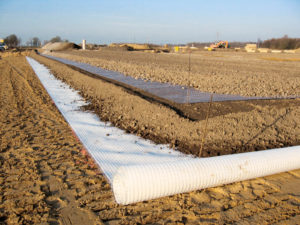
However, the configuration and thickness of the drainage structure are merely tools used by the manufacturer to meet site-specific transmissivity requirements under specified loading, gradient, and boundary conditions. In addition to thickness, geotextile variations and geonet strand shapes and alignments can also make significant performance improvements. In almost all circumstances the specified transmissivity governs the particular geocomposite used for an application.
Due to the gradation characteristics of some CCRs, specifically the finer particles associated with fly ash and gypsum, geocomposite manufacturers are working to provide products that offer adequate filtration for the fine particle sizes present. Recent innovations include the utilization of composite (woven/nonwoven) geotextiles to provide additional strength and filtration3, but also the use of existing geotextile products in new applications. Although in early stages, test data on the use of standard nonwoven geotextiles, heavier in weight than conventional geocomposites, applied to geonet products is demonstrating excellent performance in the filtration of the finer particles.
Structured geomembranes
Structured geomembranes can incorporate an integrated drainage system (IDS) into the liner component, eliminating the need for an additional geonet or geocomposite layer of drainage, and also provide a standard textured geomembrane product that produces strength test requirements significantly higher than the minimum requirements established by Geosynthetic Research Institute’s GRI-GM13 or GRI-GM17.
More than 100 million square feet of structured drainage liners have been installed, primarily in closure applications. They can provide transmissivity as well as other enhanced performance values in closure applications.
Geosynthetic clay liners (GCL)
As noted previously, federal regulations require a composite liner system using a clay component in conjunction with the geomembrane. GCLs have emerged as an acceptable alternative to the compacted clay liner (CCL) component of this composite system, as well as in other applications such as closure caps and pond liners.
GCLs are comprised of a layer of granulated or powdered sodium bentonite encapsulated between two geotextiles. The bentonite layer has a high moisture capacity and, when hydrated and subjected to load, the GCL has a low permeability. In most instances the two encapsulating geotextiles are needle-punched together to increase the internal shear strength of the material and the resulting overall stability of the completed facility. Varying degrees of needle-punching and various geotextile components can provide increased degrees of shear strength that can be witnessed through the variety of GCL products on the market.
Almost all GCLs are amended through the addition of a variety of polymers in the bentonite core. The recent trend includes the development of specialized polymer additives to create “designer GCLs” specially tailored for specific industries such as CCR disposal. Many of these special polymer amended materials are available to all GCL manufacturers; however, they may be trademarked or otherwise identified independently by GCL manufacturers.
Due to the potential for differential settlement in CCR disposal and management facilities and the resulting effects on CCLs, GCLs are typically recommended as a preferred choice over CCLs.4
Geogrids
Similar to geotextiles, geogrids offer soil and waste mass stabilization solutions that can be of critical importance in CCR management and containment facilities. Geogrids are typically used in mechanically stabilized earth (MSE) retaining walls and for improved subbase stability, both of which are increasingly being used in CCR landfills and impoundments.
Synthetic turf systems
In recent years, synthetic turf systems have entered into the disposal marketplace as alternative final and interim landfill closure systems, erosion control systems, and for aesthetics and erosion control in MSE retaining wall systems.
Geotextile tubes
High-strength geotextiles can be fabricated into containers or units called geotextile tubes. Geotextile tubes can be used in dredging applications, erosion control, and shoreline protection. Their use in waste and sludge dewatering applications have offered solutions for the CCR management and disposal industry.
Conclusion
A variety of geosynthetics are already available for use and are currently being designed, manufactured, and installed as solutions for the management and disposal of CCRs. While most of these technologies transferred directly from the municipal and industrial disposal arenas, the CCR management industry is challenging these materials for new and innovative uses. In a successful response, the geosynthetics industry is also modifying its products and developing new alternatives specifically intended for the successful containment and closure of CCR industry requirements.
Ernest H. Heins , P.E., is a business unit manager at Agru America Inc., Georgetown, S.C. He originally authored this article for the World of Coal Ash–2013 conference. It has been updated and edited for this Focus Section: Coal Ash in Geosynthetics magazine.
References
[1] Gallagher, D., and Beck, A., Geosynthetics, October/November 2012, pp.42-45.
[2] Daniels, J.L. and Hardin, C.D., “Coal Ash Management and Regulations: An Overview.”
[3] Narejo, D., “Advancements in Geosynthetic Drainage Product Development.”
[4] Koerner, R.M. and Koerner, G.R., “ Geoynthetics Opportunities with Coal Mining Spoils and Coal Combustion Residuals,” Geosynthetics Research Institute.
 TEXTILES.ORG
TEXTILES.ORG


